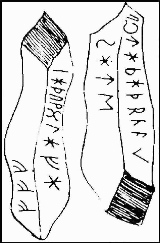
Gummarp Runestone
Encyclopedia
The Gummarp Runestone, designated as DR 358, was a runestone from the Vendel era
and which was located in the former village of Gummarp in the province of Blekinge
, Sweden
.
, where it was destroyed in the Copenhagen Fire of 1728
. The runic inscription was recorded on reproductions of the runestone. It is classified as being in runestone style RAK.
The runes read: [(h)AþuwolAfA] [sAte] [(s)tA(b)A þr(i)a] [fff]
There are two interpretations of the text. One of them reads "Haþuwulfar placed three staves fff," and the other one assumes that the word apt meaning "after" was originally placed before the name Haþuwulfar which would change the meaning into "In memory of Haþuwulfar [...] placed [these] three staves fff." The three f-runes have been interpreted as being abbreviated charm words for "wealth, wealth, wealth."
The Gummarp, Istaby Runestone
and Stentoften Runestone
inscriptions can be identified with the same clan through the names that are mentioned on them, and the names are typical for chieftains. The Björketorp Runestone
lacks names and is raised some tens of kilometers from the others. However, it is beyond doubt that the Björketorp runestone is connected to them, because in addition to the special runic forms, the same message is given on the Stentoften Runestone.
The name Haþuwulfar has the common Viking Age
name element of wulafa meaning "wolf" and heru, which when combined in personal names, means a "host" or "magnitude." It has been suggested that the assignment of such a name is related to ritualistic practices and religious wolf-symbolism used in the initiation of young warriors.
Vendel era
In Swedish prehistory, the Vendel era is the name given to a part of the Germanic Iron Age ....
and which was located in the former village of Gummarp in the province of Blekinge
Blekinge
' is one of the traditional provinces of Sweden , situated in the south of the country. It borders Småland, Scania and the Baltic Sea.The name "Blekinge" comes from the adjective bleke, which corresponds to the nautical term for "dead calm"....
, Sweden
Sweden
Sweden , officially the Kingdom of Sweden , is a Nordic country on the Scandinavian Peninsula in Northern Europe. Sweden borders with Norway and Finland and is connected to Denmark by a bridge-tunnel across the Öresund....
.
Description
The Gummarp Runestone was removed and taken to CopenhagenCopenhagen
Copenhagen is the capital and largest city of Denmark, with an urban population of 1,199,224 and a metropolitan population of 1,930,260 . With the completion of the transnational Øresund Bridge in 2000, Copenhagen has become the centre of the increasingly integrating Øresund Region...
, where it was destroyed in the Copenhagen Fire of 1728
Copenhagen Fire of 1728
The Copenhagen Fire of 1728 was the largest fire in the history of Copenhagen, Denmark. It began on the evening of October 20, 1728, and continued to burn until the morning of October 23. It destroyed approximately 28% of the city , left 20% of the population homeless, and the reconstruction lasted...
. The runic inscription was recorded on reproductions of the runestone. It is classified as being in runestone style RAK.
The runes read: [(h)AþuwolAfA] [sAte] [(s)tA(b)A þr(i)a] [fff]
There are two interpretations of the text. One of them reads "Haþuwulfar placed three staves fff," and the other one assumes that the word apt meaning "after" was originally placed before the name Haþuwulfar which would change the meaning into "In memory of Haþuwulfar [...] placed [these] three staves fff." The three f-runes have been interpreted as being abbreviated charm words for "wealth, wealth, wealth."
The Gummarp, Istaby Runestone
Istaby Runestone
The Istaby Runestone, listed in the Rundata catalog as DR 359, is a runestone with an inscription in Proto-Norse which was raised in Istaby, Blekinge, Sweden, during the Vendel era....
and Stentoften Runestone
Stentoften Runestone
The Stentoften Runestone, listed in the Rundata catalog as DR 357, is a runestone which contains a curse in Proto-Norse that was discovered in Stentoften, Blekinge, Sweden....
inscriptions can be identified with the same clan through the names that are mentioned on them, and the names are typical for chieftains. The Björketorp Runestone
Björketorp Runestone
The Björketorp Runestone in Blekinge, Sweden, is part of a grave field which includes menhirs, both solitary and forming stone circles....
lacks names and is raised some tens of kilometers from the others. However, it is beyond doubt that the Björketorp runestone is connected to them, because in addition to the special runic forms, the same message is given on the Stentoften Runestone.
The name Haþuwulfar has the common Viking Age
Viking Age
Viking Age is the term for the period in European history, especially Northern European and Scandinavian history, spanning the late 8th to 11th centuries. Scandinavian Vikings explored Europe by its oceans and rivers through trade and warfare. The Vikings also reached Iceland, Greenland,...
name element of wulafa meaning "wolf" and heru, which when combined in personal names, means a "host" or "magnitude." It has been suggested that the assignment of such a name is related to ritualistic practices and religious wolf-symbolism used in the initiation of young warriors.
Inscription
A transliteration of the runes into roman letters is:- §QA [... (h)AþuwolAfA]
- §QB [... sAte]
- §QC [... (s)tA(b)A þr(i)a]
- §QD [fff]

